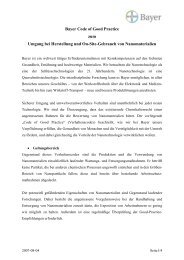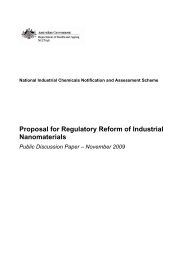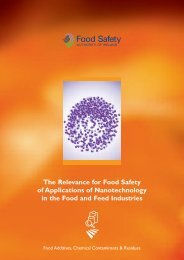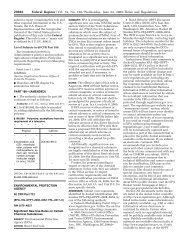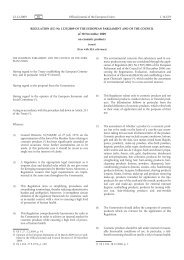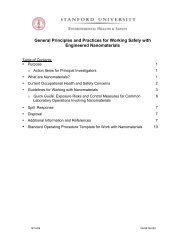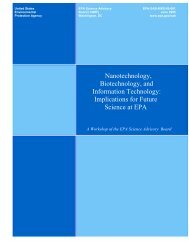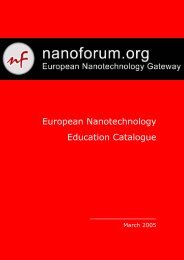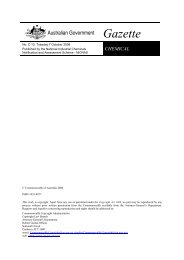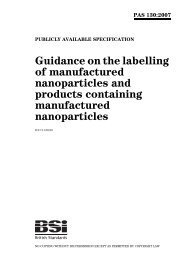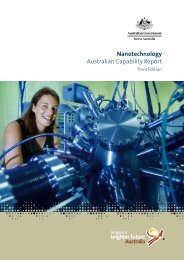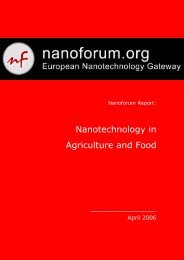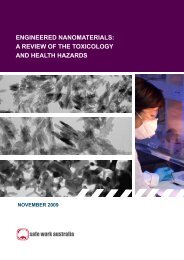Nanosciences and Nanotechnologies: An action plan for ... - EUR-Lex
Nanosciences and Nanotechnologies: An action plan for ... - EUR-Lex
Nanosciences and Nanotechnologies: An action plan for ... - EUR-Lex
Create successful ePaper yourself
Turn your PDF publications into a flip-book with our unique Google optimized e-Paper software.
ENENEN
COMMISSION OF THE <strong>EUR</strong>OPEAN COMMUNITIESBrussels, 29.10.2009COM(2009)607 finalCOMMUNICATION FROM THE COMMISSION TO THE COUNCIL, THE<strong>EUR</strong>OPEAN PARLIAMENT AND THE <strong>EUR</strong>OPEAN ECONOMIC AND SOCIALCOMMITTEE<strong>Nanosciences</strong> <strong>and</strong> <strong>Nanotechnologies</strong>: <strong>An</strong> <strong>action</strong> <strong>plan</strong> <strong>for</strong> Europe 2005-2009. SecondImplementation Report 2007-2009{SEC(2009)1468}ENEN
Support <strong>for</strong> nanotechnology research under the Community’s Framework Programmes hascontinued to grow, from <strong>EUR</strong> 1.4 billion in the four-year period 2003-2006, to more than<strong>EUR</strong> 1.1 billion in the two-year period 2007-2008. Further growth is expected in the years upto the end of the 7 th Research Framework Programme (FP7) in 2013. This investment iscomplemented by significant public funding in Member States, to the tune of more than <strong>EUR</strong>2.5 billion in 2007-2008. Private funding, however, still lagged behind public funding inEurope. At the same time, funding was increasing rapidly in other parts of the world, <strong>and</strong>dynamic new players were coming on the scene.The Community funding covered a very wide spectrum, from fundamental nanoscience toindustrial applications, with an increasing emphasis on applications. Much of this fundingcame from the cross-thematic approaches developed in FP7, as nanotechnologies have aninterdisciplinary <strong>and</strong> enabling character <strong>and</strong> can contribute to different industrial sectors <strong>and</strong>policy objectives in health, food, environment, energy <strong>and</strong> transport. The industrialparticipation in projects is gradually increasing, having reached 40 %. 5 The Commission isalso directly engaged in nanotechnology research through its Joint Research Centre (JRC),whose activities are directly linked to a number of related policy areas.This short Communication cannot do justice to the wealth of results that are being obtainedthrough EU-funded nanotechnology projects. Details are presented in the accompanying StaffWorking Document. Some examples of applications can nonetheless be outlined:– In nanoelectronics, the miniaturisation of semiconductor components enables ever morepowerful computers <strong>and</strong> other digital devices. Even smaller devices now seem possible vianovel “bottom-up” techniques.– In nanomedicine, devices based on “nanobiological” sensors are being developed, <strong>for</strong> theearly diagnosis of common diseases like cardiovascular diseases <strong>and</strong> cancers. It also seemspossible to selectively target drugs to diseased cells, thereby minimising the negative sideeffects of these drugs in other areas of the body; <strong>and</strong> to use engineered tissues <strong>for</strong>regenerative medicine.– In pilot line projects, some of the most promising laboratory results are being turned intoindustrial applications, not only to produce new materials but also to improve industrialsustainability.– In the field of energy, more efficient <strong>and</strong> less costly solar cells are being developed.Thermoelectric converters could furthermore recover heat, from internal combustionengines <strong>for</strong> example, which would otherwise be wasted.– In water remediation, nanotechnology is showing the way to more effective <strong>and</strong> less costlymethods.Whilst fundamental nanoscience <strong>and</strong> enabling research must not be neglected, it is appropriatethat the funding from the Cooperation part of the Framework Programme should increasinglytarget nanotechnology research that offers realistic short- to medium-term prospects ofproducing benefits <strong>and</strong> safe products, in fields such as health, environment <strong>and</strong> energy, <strong>and</strong> ofimproving industrial competitiveness. To ensure this, an Advisory Group on Industrial5In terms of the number of different participations, in the nanotechnology projects funded under theNMP theme of FP7 in 2007 <strong>and</strong> 2008EN 3 EN
<strong>Nanotechnologies</strong> has been created to provide further assistance in the setting of researchpriorities. This complements the Expert Advisory Groups of FP7 <strong>and</strong> the contributions ofrelevant European Technology Plat<strong>for</strong>ms. Furthermore, project clusters are being created inorder to consolidate results.Naturally, priorities need to be set with regard to different areas of nanotechnology research.The Community funding cannot cover all needs, <strong>and</strong> the public funding from Member <strong>and</strong>Associated States, currently accounting <strong>for</strong> roughly three quarters of the total public fundingin this area, is equally vital. It is also essential that the public funding be complemented byincreasing private investment.The Community funding <strong>for</strong> research on risk assessment <strong>and</strong> management (including methods<strong>and</strong> instrumentation) has continued to grow, from <strong>EUR</strong> 25 million in the four-year period2003-2006, to more than <strong>EUR</strong> 50 million in the two-year period 2007-2008. This figure,roughly 5 % of the total nanotechnology funding, is supplemented by the research on safetybuilt into projects that are closer to applications; <strong>and</strong> the support work on ethical, legal <strong>and</strong>societal issues. The main areas addressed include nanomaterial characterisation, effects onhuman health, exposure <strong>and</strong> environmental impacts. Progress has been made, notably incharacterisation <strong>and</strong> toxicology:– A number of methods to characterise nanoparticles have been validated, <strong>and</strong> new referencenanomaterials can now be used by laboratories to improve <strong>and</strong> demonstrate theirproficiency in this field of metrology.– In the field of toxicology, award-winning research is improving the underst<strong>and</strong>ing of theinter<strong>action</strong>s between nanoparticles <strong>and</strong> the human body.The EU Scientific Committees have stressed the need <strong>for</strong> further research on safety <strong>for</strong> humanhealth <strong>and</strong> the environment. The Commission intends both to enhance <strong>and</strong> to consolidatethese ef<strong>for</strong>ts in cooperation with Member States, industry <strong>and</strong> international organisations.2. INFRASTRUCTURE AND <strong>EUR</strong>OPEAN POLES OF EXCELLENCEInnovative nanotechnology necessitates research infrastructures with critical mass <strong>and</strong>interdisciplinary character, together with technology transfer mechanisms, to progress beyondresearch towards industrial innovation.The Commission has continued to support nanotechnology infrastructures by funding accessto existing facilities <strong>and</strong> the development of new facilities. Moreover, in the past two years,several FP6 Networks of Excellence have led to “durable integration” in the shape of newinstitutes <strong>and</strong> virtual infrastructures, such as the European Theoretical Spectroscopy Facility(ETSF).It is encouraging to note the ef<strong>for</strong>ts of several Member States in creating or exp<strong>and</strong>ingresearch infrastructures addressing nanotechnology. Notable amongst these are PRINS, adistributed facility <strong>for</strong> nanostructures involving Belgian, German <strong>and</strong> French centres close tothe nanoelectronics industry; the new International Iberian Nanotechnology Laboratory inBraga; the French initiative to create “nanotechnology integration centres” in Grenoble,EN 4 EN
Saclay <strong>and</strong> Toulouse; <strong>and</strong> the Gennesys 6 initiative bringing together European neutron <strong>and</strong>synchrotron facilities <strong>for</strong> research in nanotechnology applications.3. INTERDISCIPLINARY HUMAN RESOURCES: <strong>EUR</strong>OPE NEEDSCREATIVITYProgress in nanotechnology depends on a skilled work<strong>for</strong>ce <strong>and</strong> interdisciplinary approaches,which necessitate a departure from more traditional education <strong>and</strong> training schemes. It isreported 7 that industrial players consider the lack of appropriate human resources one of themajor obstacles to innovation. Training activities in nanotechnology have continued to befunded by the Commission, mainly through the Marie Curie <strong>action</strong>s of the “People”programme, which provided a total of <strong>EUR</strong> 125 million to nanotechnology projects in 2007-2008. Other projects, most notably FP6 Networks of Excellence <strong>and</strong> some EuropeanTechnology Plat<strong>for</strong>ms, have made significant contributions to training. All these contributionshave emphasised interdisciplinary approaches <strong>and</strong> the transfer of results from academia toindustry. A further contribution to nanotechnology, around <strong>EUR</strong> 80 million in 2007-2008,came from the European Research Council (ERC) implementing the “Ideas” programme. Thisoffers opportunities to individual teams through its investigator-driven approach, encouragingscientists to go beyond established frontiers of knowledge <strong>and</strong> the boundaries of disciplines.In addition, many European universities are creating nanotechnology courses <strong>and</strong> MastersDegrees. More needs to be done in the future, in quantitative terms at the very least.The European Institute of Innovation <strong>and</strong> Technology (EIT) may offer an impetus <strong>for</strong>developments in human resources <strong>and</strong> innovation. 84. INDUSTRIAL INNOVATION: FROM KNOWLEDGE TO THE MARKETGlobalisation has changed the world’s economy, bringing new opportunities <strong>and</strong> newchallenges that require Europe to become more creative <strong>and</strong> innovative. Notwithst<strong>and</strong>ing thelarge public financing of European R&D in nanotechnology, the corresponding privateinvestment remains low compared with that of Europe’s main competitors. <strong>An</strong>d Europe’sshare of nanotechnology patents does not match its share of nanotechnology publications.The Commission has supported innovation in nanotechnology through different policies <strong>and</strong><strong>action</strong>s. The main initiatives related to nanotechnology include: Increased emphasis onapplications in the research funded under FP7; a continued commitment to regulatory <strong>and</strong>st<strong>and</strong>ardisation activities; <strong>and</strong> the creation of a nanotechnology observatory,ObservatoryNANO, 9 to study opportunities <strong>and</strong> risks in various technology sectors. In thiscontext, special attention is paid to SMEs <strong>and</strong> start-ups.ENIAC, the Joint Technology Initiative (JTI) in Nanoelectronics, is an example of apioneering approach in pooling private <strong>and</strong> public ef<strong>for</strong>ts. For the first time ever, the6789http://gennesys.neutron-eu.net/In a recent OECD-WPN study, to be publishedThe first call <strong>for</strong> Knowledge <strong>and</strong> Innovation Communities, with three priority areas relevant tonanotechnology, closed in August 2009; http://eit.europa.eu/kics-call.htmlwww.observatorynano.euEN 5 EN
Community <strong>and</strong> Member States are jointly funding R&D, with a total investment of <strong>EUR</strong> 3billion until 2013.Furthermore, allocations from the Competitiveness <strong>and</strong> Innovation Programme (CIP), as wellas the structural funds of the cohesion policy, can contribute to the development ofnanotechnology.Acceptance of product <strong>and</strong> per<strong>for</strong>mance st<strong>and</strong>ards, as well as further science-baseddevelopment of new products, depends on the development of sound measurement <strong>and</strong> testingst<strong>and</strong>ards, which support product safety <strong>and</strong> quality. Over the past two years, Member Stateshave contributed to the initial development of nanotechnology st<strong>and</strong>ards. Furthermore, theCommission <strong>and</strong> the Member States have worked jointly with ISO <strong>and</strong> CEN. In the years tocome, further <strong>action</strong> is expected in this area. 10 The Commission m<strong>and</strong>ated CEN to present ast<strong>and</strong>ardisation programme <strong>and</strong> a list of proposed st<strong>and</strong>ards projects has been developed. Thisis currently being followed-up by a specific st<strong>and</strong>ardisation m<strong>and</strong>ate focusing on terminology,characterisation of nanomaterials, <strong>and</strong> methods to assess <strong>and</strong> simulate exposure.Especially at a time of economic downturn, a considerable leveraging ef<strong>for</strong>t is needed tomaximise the effect of the large public investment in research <strong>and</strong> infrastructures. This “openinnovation” approach would maintain private investment <strong>and</strong> increase it in the future.5. INTEGRATING THE SOCIETAL DIMENSION: ADDRESSINGEXPECTATIONS AND CONCERNS<strong>An</strong> essential element of the integrated, safe <strong>and</strong> responsible approach is to integrate health,safety <strong>and</strong> environmental aspects in the development of nanotechnology, <strong>and</strong> to establish aneffective dialogue with all stakeholders. Several <strong>action</strong>s were undertaken in pursuit of thegeneral objective of taking people’s expectations <strong>and</strong> concerns into account.In February 2008, the Commission adopted the recommendation <strong>for</strong> a “Code of Conduct <strong>for</strong>responsible nanosciences <strong>and</strong> nanotechnologies research”, 11 which provides guidelinesfavouring a responsible <strong>and</strong> open approach. As called <strong>for</strong> by the Council in September 2008, 12the Commission will regularly monitor the Code, <strong>and</strong> revise it every two years in order to takeinto account developments in nanotechnology <strong>and</strong> their integration in European society.All proposals that are considered <strong>for</strong> funding under FP7 <strong>and</strong> are ethically sensitive undergo athorough ethical review. They are funded only if they address ethical issues adequately <strong>and</strong>meet the necessary Community <strong>and</strong> national requirements – <strong>for</strong> example the EU Charter ofFundamental Rights. Ef<strong>for</strong>ts are made to increase the researchers’ awareness of theCommission’s Code of Conduct.A particular requirement in EU policy relates to the promotion of alternatives to animaltesting. The Commission funds research into alternative testing methods <strong>and</strong> strategies inpartnership with industry <strong>and</strong> cooperates within OECD on this issue. The Commission’s JRCis also active in the development <strong>and</strong> assessment of alternative methods.101112That is, pre- <strong>and</strong> co-normative research as well as normative <strong>action</strong>Code of Conduct <strong>for</strong> responsible nanosciences <strong>and</strong> nanotechnologies research, C(2008)42412959/1/08 REV 1 (2891 st Council Meeting Competitiveness)EN 6 EN
The likely convergence of nanotechnology with biotechnology, in<strong>for</strong>mation technology <strong>and</strong>cognitive sciences increases opportunities <strong>for</strong> beneficial applications, but also raises importantquestions relating to ethics, safety, security <strong>and</strong> respect <strong>for</strong> fundamental rights. These mayneed to be addressed by a new opinion of the European Group on Ethics in Science <strong>and</strong> NewTechnologies.Several outreach projects have been funded under FP6 <strong>and</strong> FP7. These suggest that there is aneed <strong>for</strong> a more permanent public deliberation on nanotechnology in its broad societalcontext. The Commission has pursued an active policy of engagement <strong>and</strong> consultation withstakeholders, in particular through the continuous involvement of stakeholders in Commissionworking groups in charge of coordinating the implementation of regulation; <strong>and</strong> in the annualNanotechnology “Safety <strong>for</strong> Success Dialogue” workshops. Public dialogue <strong>and</strong> engagementhave also been undertaken at national level.The call <strong>for</strong> dialogue <strong>and</strong> engagement in the Action Plan has also been reflected in variousother initiatives organised by European Technology Plat<strong>for</strong>ms <strong>and</strong> in special interest <strong>for</strong>umssuch as industry <strong>and</strong> consumers’ groups. The existence of diverse <strong>for</strong>ums indicates a need tomonitor the debates at national, European <strong>and</strong> international levels, <strong>for</strong> instance with supportfrom future FP7 activities, in order consistently to convey messages from public debates topolicy makers. On 10 September 2009, the Commission organised a scientific hearing on therisk assessment of nanotechnologies. 13The Commission has published a wide range of in<strong>for</strong>mative material in many languages <strong>and</strong><strong>for</strong> various age groups. <strong>An</strong>d a specific entry <strong>for</strong> nanotechnology on the Commission’s Europawebsite helps the public to follow all its nanotechnology activities.6. HEALTH, SAFETY, ENVIRONMENTAL AND CONSUMER PROTECTIONNanotechnology products must comply with the high levels of consumer, worker <strong>and</strong>environmental protection set out in Community legislation. These products will enjoy publicacceptance only if these regulations adequately address the new challenges from thetechnologies; if manufacturers can demonstrate their safety; <strong>and</strong> if consumers perceive themas safe.6.1. RegulationIn June 2008, the Commission adopted the Communication “Regulatory aspects ofnanomaterials”, 14 fulfilling a commitment made in the Action Plan. The Communication wasaccompanied by a Staff Working Document providing a summary of legislation in relation tohealth, safety <strong>and</strong> environmental aspects of nanomaterials, <strong>and</strong> outlining regulatory researchneeds <strong>and</strong> related measures. 15This regulatory review concluded that existing Community regulatory frameworks cover inprinciple the potential health, safety <strong>and</strong> environmental risks related to nanomaterials.Without excluding regulatory change in the light of new in<strong>for</strong>mation, the Commissionstressed that the protection of health, safety <strong>and</strong> the environment needs to be enhanced mainly131415http://ec.europa.eu/health/nanohearing_en.htmRegulatory Aspects of Nanomaterials, COM(2008)366SEC(2008)2036EN 7 EN
y improving the implementation of current legislation. In addition to supporting research onrisk assessment, the Commission is working in several regulatory areas to improveimplementation, assess the adequacy of existing legislation, <strong>and</strong> consider whether regulatorychange on specific aspects is necessary. 16The Communication was examined by both the European Parliament 17 <strong>and</strong> the EuropeanEconomic <strong>and</strong> Social Committee. 18 The European Parliament in particular questions whether,in the absence of explicit provisions <strong>for</strong> nanotechnology in Community law, legislation can bedeemed adequate to cover the risks related to nanomaterials. Given the lack of appropriatedata <strong>and</strong> assessment methods, the Parliament asks that existing regulations be carefullyreviewed. At the request of the European Parliament, specific provisions in relation tonanomaterials have been introduced or are being considered <strong>for</strong> legislation on cosmetics,novel food <strong>and</strong> food additives.As <strong>plan</strong>ned, the Commission will present an updated regulatory review in 2011, payingparticular attention to the points raised by the European Parliament <strong>and</strong> the EuropeanEconomic <strong>and</strong> Social Committee. Depending on needs, the Commission may proposeregulatory changes.6.2. Bridging the knowledge gapA specific hurdle to overcome is the need <strong>for</strong> better knowledge in areas like thecharacterisation of nanomaterials, toxicity, ecotoxicity, safety <strong>and</strong> exposure assessment. Thiswould allow implementation tools, like integrated testing strategies <strong>and</strong> guidance documents,to be adapted to take nanomaterials fully into account.Projects designed to address environmental <strong>and</strong> health safety issues, under FP7 <strong>and</strong> in theJRC, have led to a better underst<strong>and</strong>ing of the inter<strong>action</strong> mechanisms of nanomaterials withbiological systems, as well as in the development of test methods, <strong>for</strong> the assessment ofexposure <strong>for</strong> example.International cooperation in this area is strong. The Commission is heavily involved in thecurrent work within the OECD Working Party <strong>for</strong> Manufactured Nanomaterials (WPMN),which is developing test methods <strong>and</strong> guidelines <strong>for</strong> risk assessment. Moreover, the ISOst<strong>and</strong>ardisation work will facilitate a global convergence in st<strong>and</strong>ards <strong>for</strong> the implementationof regulation.The independent EU Scientific Committees have delivered six opinions in the last five yearsregarding the risk assessment of nanomaterials. In view of the remaining knowledge gaps, theopinions stress that potential risks of nanomaterials have to be assessed on a case-by-casebasis <strong>and</strong> make recommendations <strong>for</strong> further research on safety.From the regulatory point of view, there are a number of urgent needs:161718For example, the working group <strong>for</strong> nanomaterials under REACH has made progress <strong>and</strong> publishedinitial results: http://ec.europa.eu/environment/chemicals/reach/pdf/nanomaterials.pdfResolution of 24 April 2009 on regulatory aspects of nanomaterials (2008/2208(INI))Opinion of 25 February 2009 on the Communication on Regulatory Aspects of Nanomaterials,INT/456; http://eesc.europa.eu/documents/opinions/avis_en.asp?type=enEN 8 EN
living organisms, to ensure a high safety level <strong>and</strong> protection of human health <strong>and</strong> theenvironment.– Developing infrastructures <strong>and</strong> the educational system further, consistent with themultidisciplinary character of nanotechnology.– Strengthening the mechanisms available <strong>for</strong> industrial innovation, stressing the concept ofopen innovation <strong>and</strong> facilitating technology transfer.– Implementing a more direct, focused <strong>and</strong> continuous societal dialogue; <strong>and</strong> monitoringpublic opinion <strong>and</strong> issues related to consumer, environmental <strong>and</strong> worker protection.– Continuing to review the adequacy of regulation, adapting as appropriate theimplementation instruments, proposing regulatory change where necessary, <strong>and</strong> engagingwhere possible with international developments.– Surveying the market <strong>for</strong> products of nanotechnology, including their safety aspects, <strong>and</strong>likely developments.– Stepping up the research ef<strong>for</strong>t on safety assessment, including risk management,throughout the product life cycle. Supporting the further development <strong>and</strong> validation ofnanomaterial characterisation <strong>and</strong> test methods.– Enhancing coordination <strong>and</strong> exchange of in<strong>for</strong>mation with Member States.Building on achievements so far <strong>and</strong> with these needs in mind, the Commission is consideringproposing a new Nanotechnology Action Plan that would be one of the driving <strong>for</strong>ces of theEuropean Research Area <strong>and</strong> address important societal <strong>and</strong> environmental issues.EN 11 EN



